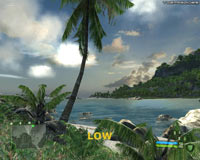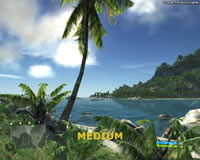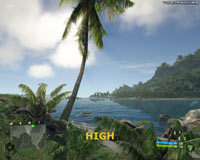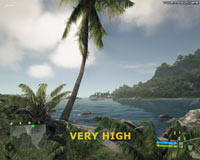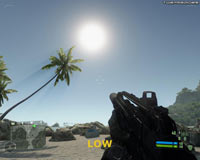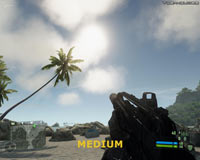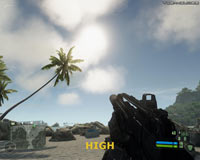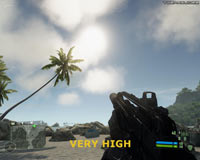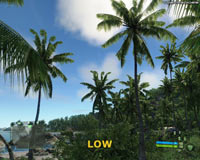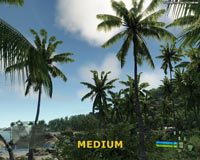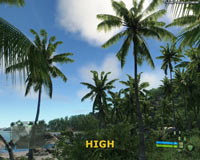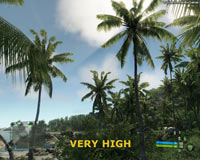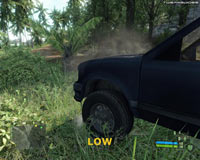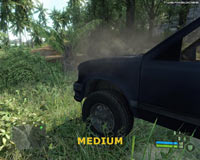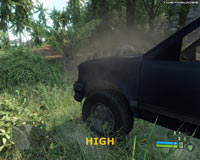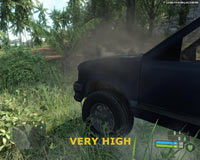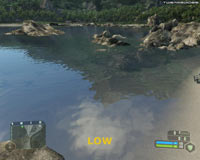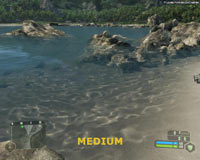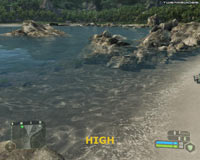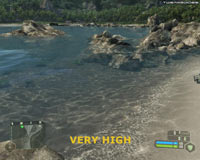Crysis Tweak Guide
[Page 7] In-Game Settings (Pt.3)
Shaders Quality:
This setting has quite possibly the most major impact on both performance and image quality in Crysis, and the screenshot comparisons above demonstrate this quite clearly. It determines the overall quality of shaders used in the game, and Crysis is heavily dependent on shader effects for virtually every visual aspect. Note that this setting must be set to High or Very High for Anti-Aliasing or Edge AA to work in the game. The most significant impacts of this setting at each level below Very High are:
Volumetric Effects Quality:
This setting basically controls the appearance of the sky, the richness and reality of it. It has a moderate impact on performance, especially noticeable at the Very High level. The most significant impacts of this setting at each level below Very High are:
Game Effects Quality:
This setting doesn't necessarily have any noticeable visual impact on the game, it mainly controls the reality of combat. Therefore the most noticeable performance and visual impacts will be felt when you are in combat situations, particularly when fighting a large number of enemy. The most significant impacts of this setting at each level below Very High are:
Post Processing Quality:
This setting controls the various post-processing effects - so called because they're applied after the image has already been composed. In other words they're additional layers of effect on top of the current image which enhance or adjust the image to look better or more stylized. This setting has a major impact on performance, especially at the higher levels. The most significant impacts of this setting at each level below Very High are:
Particles Quality:
This setting controls all the particle-based effects in the game. Any time you see smoke, dirt, even heat distortion or small insects, they are dependent on the Particles Quality setting for their richness and overall effect. The screenshot comparison above demonstrates how smoke is affected at different levels of this setting. The setting can have a pronounced impact on performance in areas with lots of particle effects - such as during explosions - but at the same time, since Crysis uses a threaded particle renderer, most dual or multi-core systems will not notice as major a slowdown as would normally be expected (See e_particles_thread and gpu_particle_physics in the Advanced Tweaking section). The most significant impacts of this setting at each level below Very High are:
Water Quality:
As the name suggests, this setting controls the way in which bodies of water behave, such as the ocean surrounding the island. The most obvious performance and image quality impacts are therefore felt in areas where water is visible, and when under water. The most significant impacts of this setting at each level below Very High are:
Sound Quality
This controls the sound quality in the game and obviously has no impact on image quality, and indeed also has minimal impact on performance on most systems with standalone sound cards. The most significant impacts of this setting at each level below Very High are:
Update: As of the 1.1 Patch, the following settings have been added to this section:
Motion Blur
This setting independently controls the level of motion blurring used in the game. It is the same as the r_motionblur command variable (See Advanced Tweaking section), and when set to Off, disables motion blurring altogether (r_motionblur 0); when set to Medium or High r_motionblur 1 is used to provide motion blur which is mainly visible when changing your view rapidly; when set to Very High (DX10 mode only), it uses r_motionblur 3 which under DX10 mode provides full view and object motion blur. Note that you can enable full view and object motion blur in DX9 mode by using r_motionblur 5.
There is also an additional slider below this setting which controls the amount of blurring used when motion blur is enabled. This setting corresponds with the r_MotionBlurShutterSpeed command variable (again, see Advanced Tweaking). At far left the slider uses a value of 0.005 for the cvar, and when at far right the value is 0.03; the default at the middle of the slider is 0.015. The further to the right the slider is taken (the higher the value for the cvar), the more blurring you will see if motion blur is enabled, and this may reduce performance or introduce a greater feeling of 'lag'.
Now that you've got a good idea of precisely what all the in-game settings actually do, I recommend spending some time reaching a reasonable compromise of the various setting levels, such that your average framerate is typically at or above 20FPS in most circumstances. This might sound low, but firstly Crysis still feels relatively smooth even at such a low framerate, and secondly, and more importantly, you can now experiment with the commands in the Advanced Tweaking section to raise this framerate slightly, particularly during combat, to better suit your needs.
Alternatively, if you want to work backwards, you can set all your in-game settings to High or Very High, and then selectively disable features and effects you feel you can sacrifice or don't want, by working through the Advanced Tweaking section, and hence try to maximize your FPS that way. Also see the Conclusion section for one other method I propose for getting Very High effects on the cheap.
Either way, the next section covers Advanced Tweaking, and will reward patient readers who invest time in reading and experimenting with the multitude of commands that follow.

